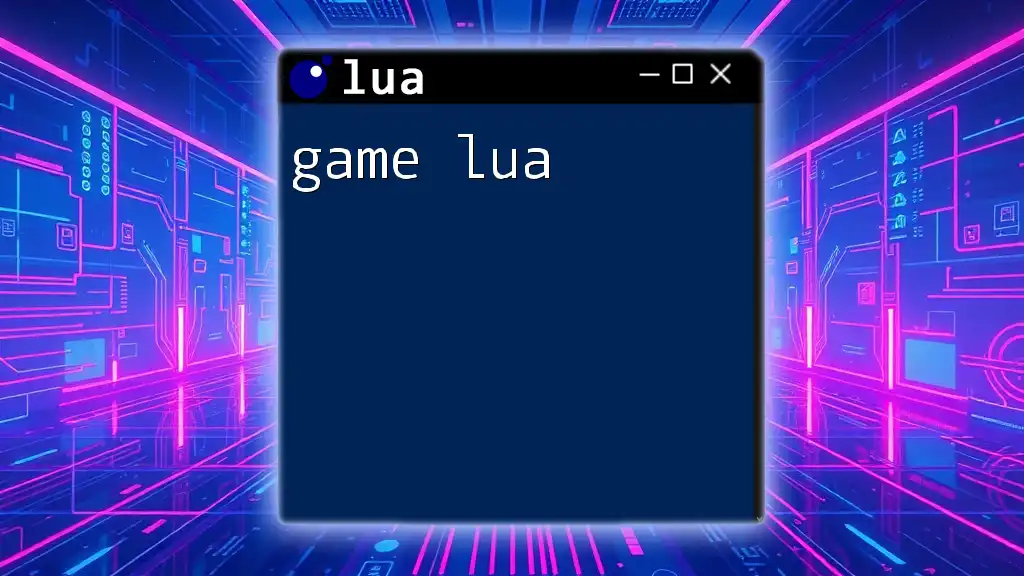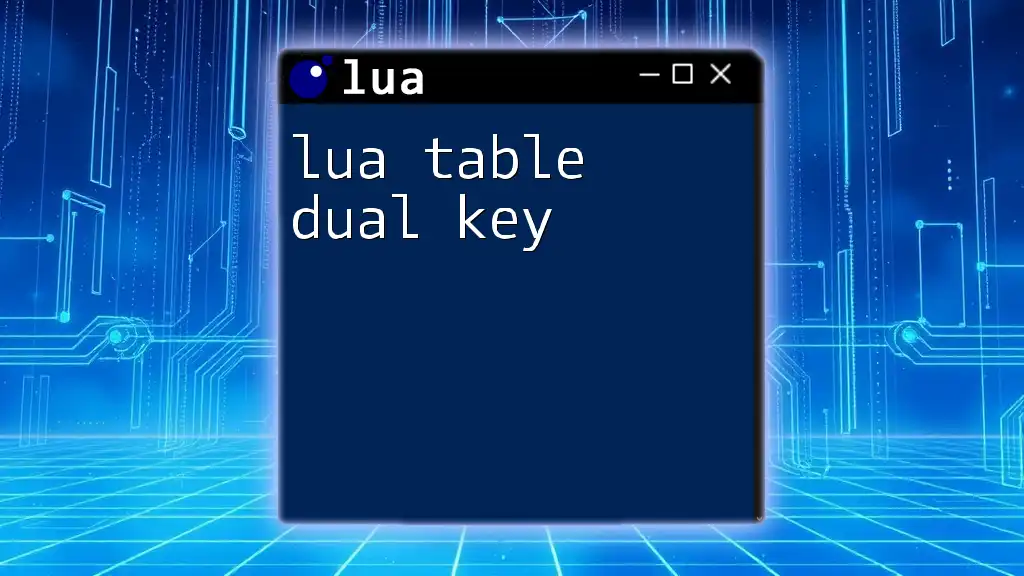To enable Lua scripting in your environment, you need to ensure the Lua interpreter is installed and properly configured in your project.
-- Example of enabling Lua in your script
require 'luarocks.loader' -- Ensure LuaRocks is loaded, if you are using LuaRocks
What is Lua?
Lua is a powerful yet lightweight programming language designed for embedded use in applications. Developed in 1993, it has gained popularity due to its simplicity and flexibility. One of the distinguishing features of Lua is its efficiency: it is fast, operates in a small footprint, and can be easily integrated into other applications thanks to its simple API.
Key Features of Lua
-
Portability: Lua is designed to run on multiple platforms without the need for modifications, making it a great choice for cross-platform applications.
-
Efficiency: The Lua interpreter is small and executes scripts quickly, making it suitable for resource-constrained environments.
-
Simplicity: With a straightforward syntax, Lua is easy to learn and use, which is beneficial for both beginners and seasoned developers.
-
Dynamic Typing: This feature allows for greater flexibility by enabling variables to hold different types of data at different times.
-
Extensibility: Lua allows users to easily integrate it with other programming languages and systems, making it versatile for various use cases.

Enabling Lua in Different Environments
Enabling Lua in Windows
To start using Lua on a Windows system, follow these straightforward steps:
Installation Steps
-
Downloading Lua: Visit the [official Lua website](https://www.lua.org/) to download the latest binaries.
-
Setting Environment Variables: After downloading, ensure that the Lua executable is added to your system's PATH variable. This will allow you to run Lua from the command line without specifying the full path.
-
Verification: To verify that Lua has been installed correctly, run the command below in your terminal:
os.execute("lua -v")
This command should return the version of Lua that you installed, confirming that the setup was successful.
Using Lua with IDEs
For an enhanced coding experience, consider using an Integrated Development Environment (IDE). Recommended IDEs like Visual Studio Code and ZeroBrane Studio offer Lua support with features such as syntax highlighting, debugging, and code completion. Set them up by configuring them to point to your Lua installation path.
Enabling Lua on macOS
macOS users can quickly enable Lua by using Homebrew, a popular package manager.
Installation via Homebrew
To install Lua, execute the following command in your terminal:
brew install lua
This command will automatically download and install Lua, along with its dependencies.
Configuration of PATH
After installation, you may want to check whether Lua is in your PATH (it typically should be). You can confirm this by running:
lua -v
This command outputs the Lua version, validating the successful installation.
Enabling Lua on Linux
Linux users have multiple options for enabling Lua, including using package managers or compiling from source.
Using Package Managers
For Debian-based systems, you can install Lua with:
sudo apt-get install lua5.3
For Red Hat-based systems, use:
sudo yum install lua
These commands will install Lua and allow you to use it immediately.
Alternative Installation Methods
If you prefer or need the latest version, you can compile Lua from the source. Follow these instructions:
-
Clone the Lua repository:
git clone https://www.lua.org/git/lua.git -
Navigate into the directory:
cd lua -
Compile Lua:
make sudo make install
This method provides you with the most up-to-date version of Lua.

Enabling Lua in Applications
Game Development with Lua
Lua is widely used in game development, often employed as a scripting language in game engines like Love2D and Corona SDK. These engines allow developers to create complex games efficiently by utilizing Lua for scripting gameplay mechanics, artificial intelligence, and more.
To enable Lua scripting in a game engine like Love2D, follow these simple steps:
-
Install Love2D from the official website.
-
Create a new project folder and include a main.lua file.
-
Write a basic script to test your setup:
function love.load() x = 400 y = 300 end function love.draw() love.graphics.circle("fill", x, y, 50) end
After saving your file, run this script using the Love2D executable. You should see a simple window displaying a filled circle, proving that Lua scripting is active.
Web Development with Lua
Lua also finds applications in web development through frameworks such as Lapis and Sailor. These frameworks enable developers to build scalable web applications utilizing Lua's simplicity.
To enable Lua in a web project using Lapis, you'll need to have OpenResty installed. Here's a simple route example using Lapis:
local lapis = require("lapis")
local app = lapis.Application()
app:get("/", function()
return "Hello, Lua!"
end)
return app
Deploying this script in a server running OpenResty provides a lightweight and efficient web application that responds with "Hello, Lua!" when accessed.

Troubleshooting Common Issues
While enabling Lua, you may encounter a few common problems:
Common Installation Problems
- Missing Dependencies: If you face an issue during installation, ensure you have the necessary dependencies installed. This may include development tools such as `gcc` for compiling Lua from source.
Execution Errors
When running Lua scripts, error messages may occur. Reading these messages properly is crucial for debugging. Typically, Lua will indicate the line number where the error happened, helping pinpoint issues in your code.
Resources for Further Assistance
The Lua community is vibrant and helpful. If you encounter any problems, consider reaching out to forums like [Lua Users](https://lua-users.org/) or exploring academic literature on Lua for valuable insights.

Best Practices for Using Lua
Code Organization
For better maintainability, structure your Lua scripts into modules. This practice will help in managing larger projects and keeps your code more organized.
Performance Optimization
To enhance performance, avoid using global variables excessively and refrain from creating new tables unnecessarily within loops. Instead, reuse existing tables for optimal efficiency.
Learning Resources
There’s a wealth of information available for learning Lua. Recommended resources include:
- Books: "Programming in Lua" is an excellent place to start, offering a deep dive into the language.
- Online Courses: Platforms like Coursera and Udemy have structured courses tailored for beginners.
- Documentation: The [official Lua documentation](https://www.lua.org/manual/5.1/) is an invaluable resource for understanding the intricacies of the language.

Conclusion
Enabling Lua is a straightforward process across various platforms and applications. By following the outlined steps, you can effectively integrate Lua into your projects, whether for game development, web applications, or other uses. The versatility and efficiency of Lua offer an endless array of possibilities for developers, making it a valuable language to learn and utilize.

Call to Action
We encourage you to share your experiences with enabling Lua and any tips you've discovered along the way. Stay connected by signing up for our newsletter for more Lua insights, tips, and tutorials, and join the vibrant Lua community!

















